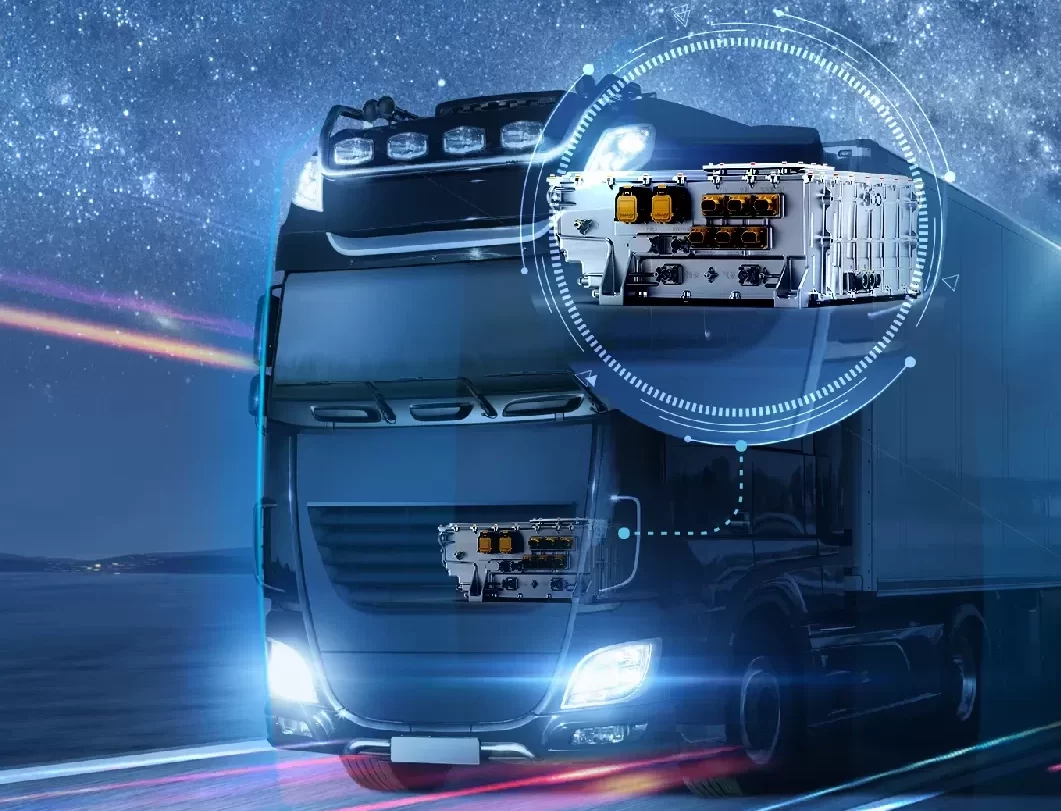Overview of Electric Vehicles and EV Powertrain
An electric vehicle (EV) is a type of transportation vehicle that relies on electrical energy for power. Its power source is usually a rechargeable battery (BEV, pure electric vehicle) or a hydrogen fuel cell (FCEV, fuel cell electric vehicle). Compared to traditional internal combustion engine vehicles, EVs do not produce tailpipe emissions during operation, and thus are considered an important way to realize green transportation.
The EV powertrain is the system that converts electrical energy into mechanical kinetic energy to drive the vehicle. It not only determines the power performance and energy efficiency of the vehicle, but also greatly affects the responsiveness, smoothness and maintenance cost of the entire vehicle. A typical EV powertrain consists of an electrical energy storage system (battery or fuel cell), a power electronics module (inverter/converter and control system), an electric motor system (drive motor), and a mechanical transmission system (e.g., single-speed gearbox). In addition, the EV’s drivetrain (transmission) includes mechanical structures such as axles and differentials.
With the maturity of EV technology and policy promotion, pure electric vehicles (BEVs) are gradually becoming mainstream. in 2023, BEVs account for 70% of global EV ownership, and up to 98% of electric light commercial vehicle sales in 2022. This is mainly due to its advantages of simple structure, low maintenance cost and low operating noise.Key Components of an EV Main Components of EV Powertrains
Main Components of the EV Powertrain
The EV powertrain can be divided into four core systems:
- Power Generation System: Includes the battery pack, onboard charger, and battery management system (BMS). It serves as the source of electrical energy.
- Power Distribution System: Controls and regulates current flow to various components. It mainly includes inverters, DC-DC converters, vehicle control units (VCU), and power distribution units (PDU).
- Electro-Mechanical Conversion System: Refers to the electric motor and its control system, which converts electrical energy into mechanical energy.
- Transmission System: Transfers torque from the motor to the wheels through gearboxes and differentials to propel the vehicle.
These four systems work closely together to achieve a complete closed-loop process—from power supply, control, to driving. The following sections will detail each system.
EV Power System: Battery, Charger, and Energy Management
The EV power system mainly consists of the following components:
Battery Pack
Currently, lithium-ion batteries are the mainstream choice, offering high energy density and good charge/discharge performance. A battery pack consists of multiple individual cells, with a voltage usually ranging from 300–800V, providing the main power source for vehicle propulsion.
Battery Management System (BMS)
The BMS monitors the voltage, current, and temperature of each cell in real time, preventing overcharging, over-discharging, or overheating, ensuring safe battery operation while extending its lifespan.
Onboard Charger (OBC)
The onboard charger converts external AC power into DC power for battery charging. It communicates with the charging station using specific protocols to regulate charging power and control the charging process. Some advanced chargers also integrate cybersecurity features to prevent remote attacks.
EV Power Distribution System: Electrical Control and Power Management
The EV power distribution system uses various power electronic components to achieve efficient and safe energy transmission and control:
Inverter (DC-AC Inverter)
The inverter converts DC power from the battery into AC power required by the motor. Modern inverters often use IGBT or SiC MOSFET devices, whose high-speed switching capabilities enable precise control of motor speed and output torque. It is a core component of EV power control.
DC-DC Converter
Used to step down high-voltage DC to 12V or 48V low-voltage DC for use by onboard electronics such as air conditioning, lighting, and multimedia systems. Some vehicles integrate the DC-DC converter, charger, and junction box into a single power module.
Vehicle Control Unit (VCU)
The VCU acts as the “central nervous system” of the vehicle. It collects and processes data from sensors across subsystems, coordinating the operation of the inverter, battery, charger, and motor to ensure optimal performance under all driving conditions.
Power Distribution Unit (PDU)
The PDU distributes electrical power to various functional modules. It integrates fuses, relays, power switches, and semiconductor protection devices to prevent overcurrent and enable fast power cutoff or circuit reconfiguration.
Through these high-performance electrical control and power distribution modules, EVs achieve precise and intelligent energy control, significantly enhancing system reliability and safety.
Electro-Mechanical Conversion System: Drive Motor and Motor Controller
The electro-mechanical conversion system is one of the core modules of the EV powertrain. It primarily includes the electric motor and its controller, responsible for efficiently converting electrical energy into mechanical energy to drive the vehicle.
Electric Motor
Common types of drive motors include:
- Permanent Magnet Synchronous Motor (PMSM): Offers high efficiency and high power density; now the mainstream choice.
- Induction Motor (IM): Simple structure and low cost; used in early Tesla Model S models.
- Switched Reluctance Motor (SRM): Resistant to high temperatures, no permanent magnet materials, suitable for high-load applications.
Motor selection is typically based on the vehicle’s performance requirements (e.g., maximum torque, acceleration time, top speed) and usage scenarios (e.g., urban commuting, long-haul transport).
Motor Controller (MCU)
The motor controller is the brain of the drive system. Based on commands from the VCU, it precisely controls motor speed and torque. Key functions include:
- Field-Oriented Control (FOC): Achieves high dynamic response and stability.
- Speed Detection and Feedback Control: Ensures actual motor operation matches target values.
- Regenerative Braking: Recovers kinetic energy during deceleration back into the battery, improving range.
High-performance controllers also support self-diagnostic functions, including overtemperature protection, overcurrent protection, and insulation monitoring, to ensure safe operation.
Transmission System: Gearbox and Differential
The mechanical transmission system of an EV is simpler than that of a conventional vehicle. The common configuration is a single-speed reducer (single-speed reduction gear) combined with a differential, meeting most driving needs.
Reducer (Reduction Gear)
Since electric motors provide high speed and high torque output, multi-gear transmissions are generally unnecessary. The reducer lowers the motor’s high-speed rotation to a low-speed, high-torque output suitable for driving the wheels.
Its advantages include:
- Simple structure, enhancing system reliability.
- Lower maintenance costs.
- Reduced shifting impact, improving ride smoothness.
Some high-performance or commercial vehicles may adopt two-speed transmissions or electronic differential structures to improve efficiency and driving experience.
Differential
The differential allows the left and right wheels to rotate at different speeds when turning, improving handling stability. Some EVs also use electronic limited-slip differentials (eLSD), combining electronic control logic to optimize traction force distribution on complex road conditions.
It is worth noting that with the rise of integrated solutions like the electric axle (e-Axle), where the motor, controller, and reducer are combined into a single unit, the overall weight of the vehicle is significantly reduced, and space layout is optimized. This represents an important direction for platform integration in modern EV design.

Future Trends and Development Directions of EV Powertrains
With the rapid development of the EV industry, EV powertrains are evolving toward higher integration, higher efficiency, and lower cost:
High Integration: 3-in-1 / 5-in-1 Drive Systems
Deep integration of motor, controller, and reducer forms a “3-in-1” drive unit. Further integration with inverters, DC-DC converters, and chargers leads to “5-in-1” or even “7-in-1” systems. These reduce wiring, save space, and lower assembly costs, serving as key supports for lightweight and modular vehicle platforms.
High-Voltage Platforms: Accelerated Adoption of 800V Systems
Compared to traditional 400V platforms, 800V high-voltage systems significantly reduce current and energy loss, and greatly shorten fast-charging times. For example, the Porsche Taycan achieves 100km of range in just 5 minutes of charging on an 800V platform, making it a key feature for high-end EVs.
Upgraded Power Semiconductors: Application of SiC Technology
Silicon carbide (SiC) devices are gradually replacing traditional silicon-based IGBTs in inverters, DC-DC converters, and chargers. They offer higher electrical efficiency and lower thermal losses, supporting high-voltage systems and long-range platforms.
Software-Defined Powertrains
Through OTA updates, virtual sensors, and AI prediction algorithms, motor response, energy recovery, and adaptive tuning can be intelligently controlled, bringing the EV driving experience closer to—or even beyond—that of traditional internal combustion engine vehicles.
As intelligence and electrification continue to merge deeply, future EV powertrains will no longer be mere hardware combinations but highly intelligent, coordinated system engineering.
Discover Advanced EV Motor Drive Solutions with GTAKE
As electric vehicles evolve toward higher efficiency, smarter control, and deeper integration, selecting a reliable and intelligent motor drive system becomes crucial.
GTAKE specializes in high-performance electric vehicle motor drives that combine advanced control algorithms, robust hardware design, and automotive-grade reliability.
